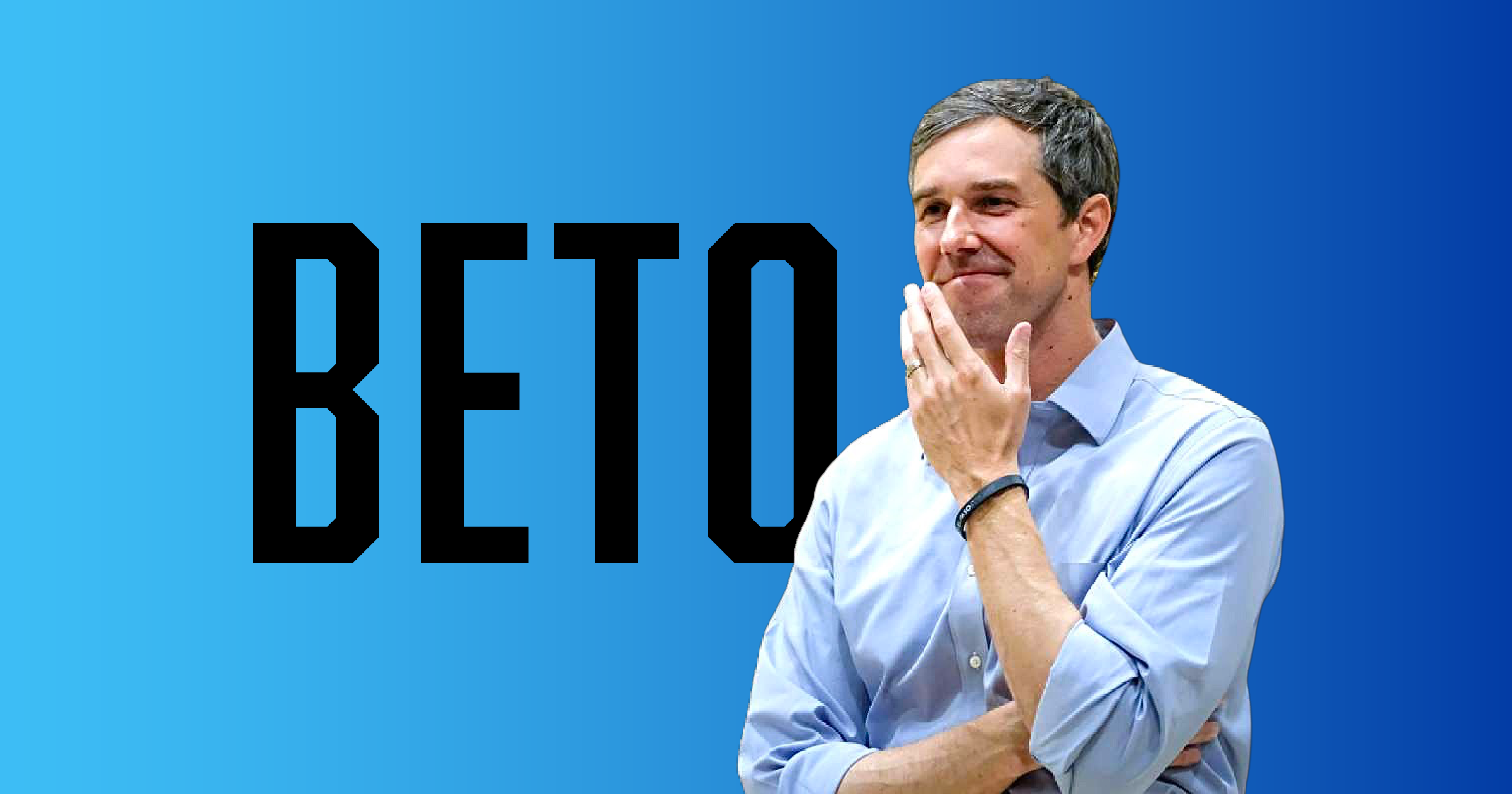The rhythmic banging of drums pulsated through the thousand-person crowd at Austin’s Republic Square Park on Saturday night. Sign-waving attendees danced and chanted, their voices ringing across the downtown gathering ground, which was ensconced in the glow of brightly lit skyscrapers. It felt like a party. And it looked like one, too.
The energy ratcheted up another level when a familiar voice echoed out from the speakers that lined the park’s periphery. Taking the small, black stage backlit by industrial lights and encircled by music festival–style metal barriers, Beto O’Rourke threw up his hand and waved to the frenzied onlookers.
After thanking Texas State Representative Gina Hinajosa, who had roused the group before introducing him, the Democratic gubernatorial candidate adjusted the burnt orange UT cap atop his head and sprung into action.
“I’m here to tell you that I believe in you. I believe in us. And I believe in this state,” he declared. “Because you have shown me what is possible. In February, when the power went out in the energy capital of North America, when the lights wouldn’t turn on and the water stopped flowing because the pipes froze, you all got together. You put your differences aside. You looked squarely forward and asked your fellow Austinites, your fellow Texans, your neighbors, how you could help them.”
It was a powerful, but familiar, opening statement from the former congressman and Senate candidate. Since declaring his candidacy in mid-November, he’s made a habit out of hammering Gov. Greg Abbott’s inaction following last February’s catastrophic grid failure. It’s an effective strategy, too: Every Texan remembers where they were when their lights went out and they had to weather sub-zero temperatures with nothing but blankets and dwindling pantry reserves. The key for O’Rourke is to ensure that they don’t forget that feeling — or the fact that, while Abbott falsely blamed wind turbines for the outage, the Democrat drove from El Paso to Austin with a pallet of bottled water in the back of his pickup truck.
Over the next fifteen minutes, O’Rourke landed blow after blow on the governor. Republicans’ attacks on abortion, their targeted stripping of voting rights with SB 1, their expansion of gun access despite police chiefs’ protests, their calculated disenfrachisement of communities of color during this fall’s redistricting — he covered it all in a flurry of rhetorical haymakers. The crowd loved it.
But his message was hardly one defined by negativity. Instead, as his first words suggested, it was one of hope, of trust. From legalizing maijuana and expanding Medicaid to protecting a woman’s right to choose, he struck a positive, but defiant, cord with every policy proposal he laid out. It felt like a breath of fresh air for many people there, the majority of whom were young people.
UT sophomore George Boghs was in the crowd. At just 19 years old, he’d only had the chance to vote in one election before — the 2020 presidential contest. That hadn’t stopped the government major from getting involved in O’Rourke 2018 U.S. Senate run, though. As a high schooler in McAllen, he’d attended political rally after political rally and spent hours volunteering for the Democrat’s campaign against Sen. Ted Cruz. Seeing that race up-close, but being unable to vote in it, made O’Rourke’s historically close loss all the more painful. Now, he’s using that as motivation for 2022.
“Beto was really the first political candidate that I fell in love with. He’s the reason I’m so interested in politics now,” Boghs said, adding that he was especially frustrated by Gov. Abbott’s dangerous embrace of permitless carry for guns. “It was hard watching that election without being able to actually be a part of the process. That’s not the case this time. I’m going to do everything I can to help make him the next governor of Texas.”
26-year-old Amanda Sewell shared a similar perspective just minutes before O’Rourke took the stage. As a senior at Texas State University, Sewell had caught one of his 2018 rallies while on a five-minute break from her on-campus job. She was immediately struck by his charisma and optimism and became an impassioned supporter. Now, almost four years later, she said the fire that experience lit in her is heating up again.
“He’s different from other candidates. He’s younger and has progressive values. It’s almost like seeing yourself up there while he’s talking. He’s what we need here in Texas right now — not the older, outdated, backward politicians who are warping our futures,” she said. “Nothing speaks to that more than Abbott’s abortion ban. Texas’ treatment of women has been so demoralizing and dangerous. Navigating the winter freeze was terrifying, too. It was such a helpless feeling knowing that my grandparents were isolated and alone at such a dire time back in San Angelo, where I’m from.”
While anecdotal, Boghs and Sewell’s perspectives speak to a larger phenomenon that will prove critical to O’Rourke’s chances next fall. Yes, he’s got a clear chance to unseat his increasingly unpopular opponent and his out-of-touch right-wing policies, but that won’t happen without a historic turnout fueled by young Texans. That’s going to be a tall task, especially considering it’s going to be during a midterm election — which typically draws fewer voters than presidential years.
But if Saturday’s rally was any indicator, O’Rourke’s message about trust, progress, and pushing past Abbott’s authoritarian regime is working so far. Young voters appear tuned in and ready to make history in 2022.
“To do this, we’ve got to do it together. We’ve got to commit ourselves right now, just like you did in February. Let’s put our differences behind us and firmly focus on the future of this state,” O’Rourke said in his closing remarks. “Together, we will deliver this state from a man who can literally not be trusted to deliver power to the people when they need it most. And we’re going to ensure that we elect a governor who will always keep the lights on, and who understands that the real power in Texas is the people of his state.”





